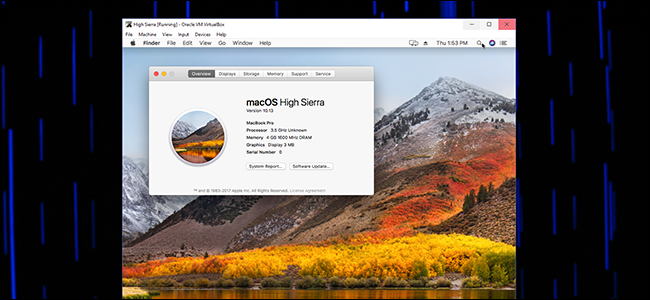

You can convert the installer DMG to an ISO, using the script at the end of this answer. The autorun installer can be quit so that it can be converted to an ISO) (App store app puts it into /Applications and launches it. macOS High Sierra 10.13.6 (probably works with several macOS release versions)įirst download High Sierra installer from app store. VirtualBox 5.2.19 (no foreseeable reason future revs of VirtualBox won't work)

You can also refer to Oracle's User Manual for VirtualBoxif you have any questions.Late 2015 Retina iMac (probably any new enough Mac will work) Now that you're up and running, be sure to check out some of our other guides on VirtualBox and VMs. Your Windows 10 VM is now ready to go on your Mac! If you ever want to change any of the settings, just right-click the VM, and then click “Settings.” In this window, click “Add.” Select the ISO file, click “Open,” and then click “Start.” Click the folder with the green up arrow. Otherwise, a new window opens so you can do this manually. If the Windows 10 ISO is already on your computer, VirtualBox might try to identify and select it automatically. Save the ISO file to your computer, go back to VirtualBox, and then click “Start.” You can download the free Windows 10 disc imagedirectly from Microsoft.

However, just like on any physical machine, you have to set up the Windows 10 OS. You've now successfully installed VirtualBox and a Windows 10 VM. If you chose “Fixed Size” in the previous screen, click “Create.” VirtualBox will begin allotting that space. Lastly, you have to decide where to store your VM, and how much storage it needs. On the next screen, if you want a faster setup, select “Dynamically Allocated.” If you want faster performance (which we recommend), select “Fixed Size,” and then click “Continue.” However, you're installing a Microsoft product, so you need to choose the format it uses, which is “VHD (Virtual Hard Disk).” Click the radio button next to that option, and then click “Continue.” The default is “VDI (VirtualBox Disk Image),” which is Oracle's proprietary container format.

Next, you have to decide which type of hard disk to create.


 0 kommentar(er)
0 kommentar(er)
